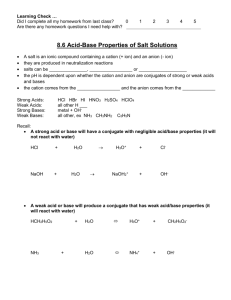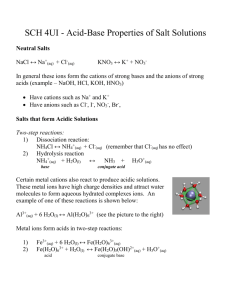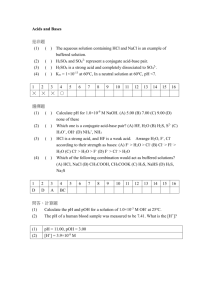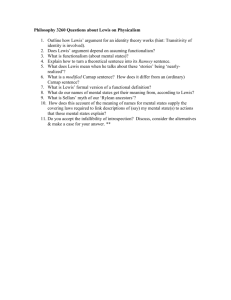acid base rxns, pH salts, Lewis acid-base
advertisement
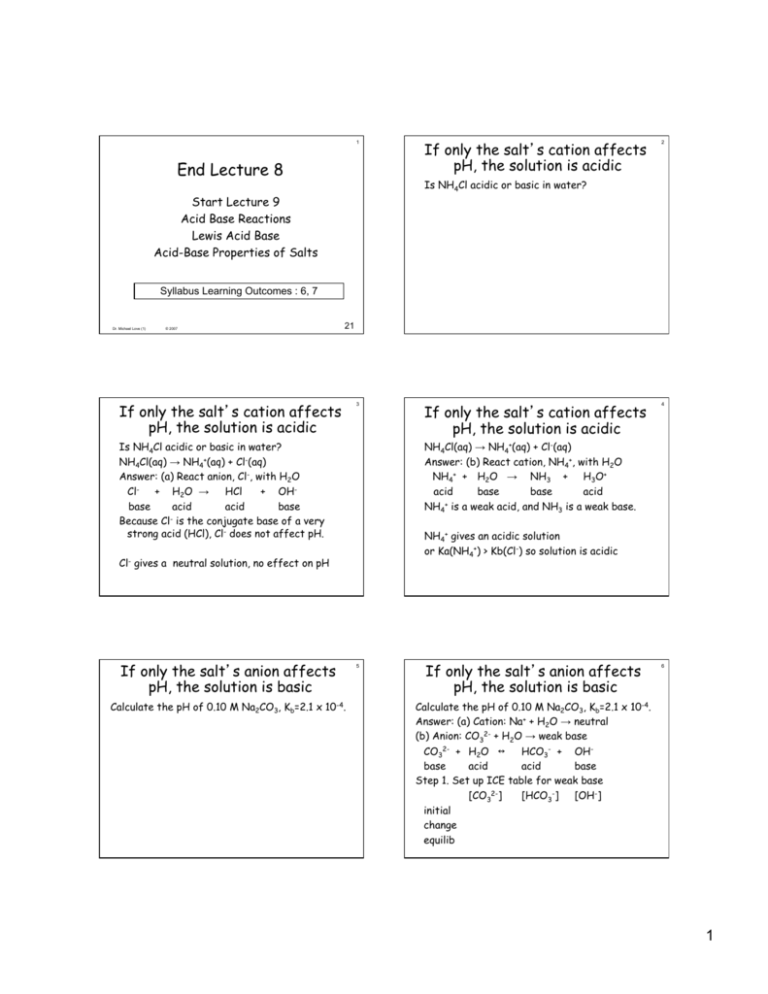
1 End Lecture 8 If only the salt s cation affects pH, the solution is acidic 2 Is NH4Cl acidic or basic in water? Start Lecture 9 Acid Base Reactions Lewis Acid Base Acid-Base Properties of Salts Syllabus Learning Outcomes : 6, 7 Dr. Michael Love (1) © 2007 21 If only the salt s cation affects pH, the solution is acidic 3 Is NH4Cl acidic or basic in water? NH4Cl(aq) → NH4+(aq) + Cl-(aq) Answer: (a) React anion, Cl-, with H2O Cl- + H2O → HCl + OHbase acid acid base Because Cl- is the conjugate base of a very strong acid (HCl), Cl- does not affect pH. Calculate the pH of 0.10 M Na2CO3, Kb=2.1 x 10-4. 4 NH4Cl(aq) → NH4+(aq) + Cl-(aq) Answer: (b) React cation, NH4+, with H2O NH4+ + H2O → NH3 + H3O+ acid base base acid NH4+ is a weak acid, and NH3 is a weak base. NH4+ gives an acidic solution or Ka(NH4+) > Kb(Cl-) so solution is acidic Cl- gives a neutral solution, no effect on pH If only the salt s anion affects pH, the solution is basic If only the salt s cation affects pH, the solution is acidic 5 If only the salt s anion affects pH, the solution is basic 6 Calculate the pH of 0.10 M Na2CO3, Kb=2.1 x 10-4. Answer: (a) Cation: Na+ + H2O → neutral (b) Anion: CO32- + H2O → weak base CO32- + H2O ↔ HCO3- + OHbase acid acid base Step 1. Set up ICE table for weak base [CO32-] [HCO3-] [OH-] initial change equilib 1 If only the salt s anion affects pH, the solution is basic 7 Calculate the pH of 0.10 M Na2CO3, Kb=2.1 x 10-4. Answer: (a) Cation: Na+ + H2O → neutral (b) Anion: CO32- + H2O → weak base CO32- + H2O ↔ HCO3- + OHbase acid acid base Step 1. Set up ICE table for weak base [CO32-] [HCO3-] [OH-] initial 0.10 0 0 change -x +x +x equilib 0.10 - x x x If neither the salt s cation nor anion affects pH, the solution is neutral, pH=7 If only the salt s anion affects pH, the solution is basic 8 Calculate the pH of 0.10 M Na2CO3, Kb=2.1 x 10-4. Step 2. Solve equilibrium expression [HCO3-][OH-] x2 Kb= 2.1x10-4 = ―――――― = ――― [CO32-] 0.10-x 100*Kb<0.1, so 0.10-x ≈ 0.10, giving x= [HCO3-]= [OH-]= 0.00458M pOH= 2.33, and pH= 11.66 0.1M Na2CO3 is a basic solution. 9 Is 0.1M NaCl acidic or basic in water? If neither the salt s cation nor anion affects pH, the solution is neutral, pH=7 10 Is 0.1M NaCl acidic or basic in water? Answer: (a) We did Na+ and Cl−, before. Neither Na+ nor Cl− affect pH (Na+ from NaOH and Cl− from HCl). 0.1M NaCl is neutral in water. If both the salt s cation and anion affect pH, the larger of Ka and Kb determine pH Is 0.1M NH4Bz acidic or basic in water? 11 If both the salt s cation and anion affect pH, the larger of Ka and Kb determine pH 12 Is 0.1M NH4Bz acidic or basic in water? Answer: Look up Ka(NH4+) and Kb(Bz−) (a) Ka for NH4+ = 5.6x10-10 (b) Kb for Bz− = 1.6x10-10 Ka(NH4+) > Kb(Bz−) NH4Bz makes weakly acidic aqueous solutions. 2 Lewis acids and bases react H ― H 18 2+ H3N―Cu―NH3 ― + N― H 4H― H NH3 ― ― ― H H 3+ 2+ ― 3 Fe―OH2 ― + ― Fe Cu NH3 OH2 : 3+ : O― N― H H― H Lewis acids & bases react 2+ H3N―Zn―NH3 ― Base : Acid + Metal ions form coordinate covalent bonds and complex ions ― + ― Zn ― : NH3 H ― ― 17 Metal ions form coordinate covalent bonds and complex ions N― H 4H― H + N― H H― H ― H + H Lewis acids & bases react 2+ : ― H Lewis acids & bases react + H ―O ― :O + 16 Ammonium ion has a coordinate covalent bond : + : H H ― ― hydronium ion has a coordinate covalent bond H ― : ― N― H H― H 15 Lewis acids & bases react H + N― H H― H • New bond (Coordinate covalent bond) forms using electron pair H from the Lewis base. H― H B― • Geometry changes after reaction (VSEPR N― model). H H― H ― ― H ―B : Lewis base: a substance that donates an electron pair 14 H ―B ― Lewis acid: a substance that accepts an electron pair 13 ― Define Lewis acid & Lewis base H NH3 As a result, copper ion (a Lewis acid) can react with ammonia (a Lewis base). OH2 3 Lewis acids & bases react in biology 19 Many water-containing complex ions hydrolyze (undergo hydrolysis) to give acidic solutions. • The heme group in hemoglobin interacts with O2 and CO. • The Fe ion in hemoglobin is a Lewis acid • O2 and CO can act as Lewis bases • CO has a strong (irreversible) binding constant with hemoglobin, whereas O2 binds more weakly and reversibly. [Cu(H2O)4]2+ + H2O → [Cu(H2O)3(OH)]+ + H3O+ 21 Al(OH)3(s) + 3 H+ → Al3+ + 3 H2O Cu2+―OH2 bond weakens this O―H bond allowing another H2O to take H+, (hydrolysis) : + ― : O― Here Al(OH)3 is a Brønsted base. Al(OH)3(s) + OH- → Al(OH)4- Al3+ ß :OH− Here Al(OH)3 is a Lewis acid. : ― H H 22 Brønsted and Lewis theories explain amphoteric nature of some metal hydroxides. Hydrolysis makes solutions of Fe3+, Al3+, Cu2+, and Pb2+ acidic. − 2+ ― O : Cu H H 23 Complex ion formation can dissolve a precipitate AgCl(s) ↔ Ag+ + Cl- Ag+ + 2NH3 ↔ Ag(NH3)2+ 20 Ksp = 1.8 x 10-10 Kform = 1.6 x 107 ―――――――――――――――― AgCl(s) + 2NH3 ↔ Ag(NH3)2+ + Cl- 24 CH3CO2H is an Acid 1. Electronegativity of O atoms takes e−, weakening O―H bond. 2. H atom in O—H can be taken by H2O to form H3O+. Knet= : O― H ― + H : O − CH3― C―O = Knet = Ksp*Kform = 2.9x10-3, so some precipitate dissolves H 4 25 CH3CO2H Trichloroacetic acid 10-5 NO3- Ka = 0.3 Least basic • Trichloroacetic acid is stronger than acetic acid because electronegative Cl in -CCl3 stabilizes ―O− anion more than the H in -CH3. Basisity oxoanions é as #Oê Least basic ClO3- 26 CCl3CO2H Acetic acid Ka = 1.8 x Basisity oxoanions as − charge CO32- PO43Most basic As charge , water interaction , basicity These are both Bronsted and Lewis bases 27 Most basic < ClO2- < ClO- As # oxygens é , strength of acid é, basicity conjugate base ê. Recall that HClO4 is a strong acid. 5
